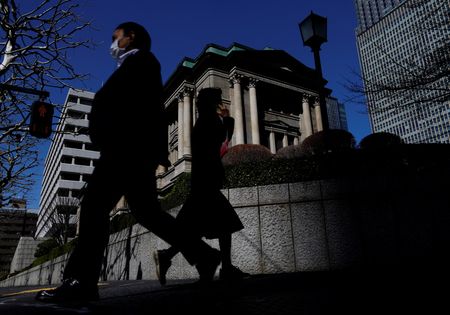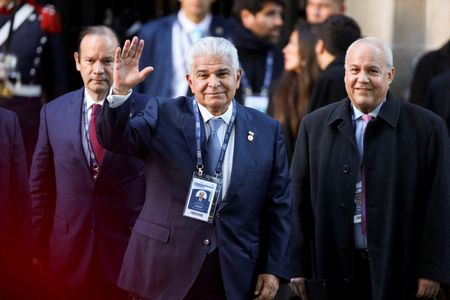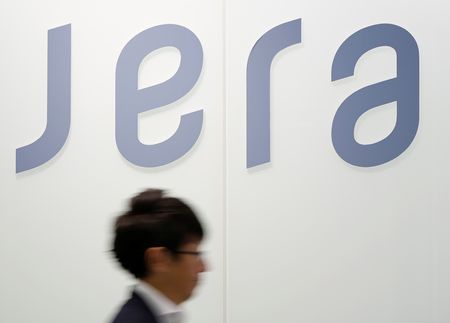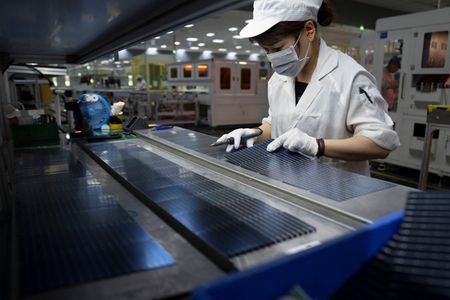(Reuters) -The Bank of Japan kept interest rates steady on Thursday and raised its inflation forecast for the current fiscal year, signalling cautious optimism that Japan’s trade deal with the U.S. would help the economy avert a steep downturn.
As widely expected, the central bank maintained short-term interest rates at 0.5% by a unanimous vote at the two-day policy meeting that ended on Thursday.
In a quarterly outlook report, the board revised up its core consumer inflation forecast for the current fiscal year to 2.7% from 2.2% projected three months ago.
COMMENTS
SHOKI OMORI, CHIEF DESK STRATEGIST, MIZUHO SECURITIES, TOKYO:
“Markets reacted only modestly, and attention now centres on Governor Ueda’s post-meeting remarks for any hawkish tilt.
“Barring a dramatic pivot at the post-meeting briefing, we continue to envisage a medium- to long-end JGB curve that flattens in bearish fashion – higher yields on the short end, stubborn calm farther out.
“Japan’s summer lull should keep domestic bond trading supply-demand driven.
“Near-term USD/JPY moves are expected to hinge on U.S. data and yields.”
SAISUKE SAKAI, CHIEF JAPAN ECONOMIST, MIZUHO RESEARCH& TECHNOLOGIES, TOKYO:
“U.S. tariffs had posed a significant obstacle to the Bank of Japan’s plans to raise interest rates. As Japan reached a trade deal with the U.S., tariff concerns have subsided and the Japanese economy looks likely to avoid a recession.
“The BOJ likely believes that the positive cycle between wages and prices remains intact.”
“We expect the next rate hike in January, but it could be pushed forward to October if the yen depreciates further.”
CHARU CHANANA, CHIEF INVESTMENT STRATEGIST, SAXO, SINGAPORE:
“Even if Governor Ueda strikes a cautious note at today’s press conference, the upward revision in growth and inflation projections clearly sets the stage for further policy normalization. The September meeting should now be viewed as a live event for a potential rate hike, assuming incoming data continues to align with the BOJ’s revised outlook.”
HIROFUMI SUZUKI, CHIEF CURRENCY STRATEGIST AT SMBC, TOKYO:
“The inflation outlook for fiscal 2025 has been significantly revised upward. Additionally, an important point is that the core CPI forecast for fiscal 2027 is set at 2.0%, and regarding the risk balance, the inflation outlook is considered to be generally balanced both upward and downward. This result justifies a rate hike between September and October, provided that various risks do not materialize in the future.”
PRASHANT NEWNAHA, SENIOR ASIA-PACIFIC RATES STRATEGIST, TD SECURITIES, SINGAPORE:
“Despite the U.S.-Japan tariff deal, the BOJ remains cautious. On inflation, the risks are now ‘balanced’ vs to the ‘downside’ in their previous report. For the BOJ to hike in October, it will probably require another bump up in their inflation forecasts. We will look for any supporting evidence for this in Ueda’s press conference.”
DAVID CHAO, GLOBAL MARKET STRATEGIST FOR ASIA-PACIFIC, INVESCO, SINGAPORE:
“The inflation forecast being raised suggests a higher likelihood for a rate hike, which is why the yen is rallying a bit.
“Today’s announcement increases the chance of an earlier than expected rate hike. It’s possible we could see a rate hike as soon as October.”
KATSUTOSHI INADOME, SENIOR STRATEGIST, SUMITOMO MITSUI TRUST ASSET MANAGEMENT, TOKYO:
“The statement is overall hawkish, with the BOJ raising price outlook. But this hawkishness was within expectations.
“In the economic outlook report, the BOJ said risks to prices are balanced. This is one of the signs that the BOJ turned hawkish, as in the previous report, the BOJ only saw downside risk in the price outlook. Also, the BOJ sees less uncertainty in global trade, and that is a reaction to trade agreements made with the U.S. over the tariffs.”
KHOON GOH, HEAD OF ASIA RESEARCH, ANZ, SINGAPORE:
“The decision itself and actually the forecast upgrade is no surprise. The BOJ had already earlier signaled that there’s upside risk to their inflation forecast. So the fact that they revised it up today is no surprise.
“There is definitely a clear justification for them to hike rates. The question is whether or not the ongoing uncertainty in the trading environment would cause them to hold off again.
“Now, the fact that Japan has finally reached a deal with the U.S. does remove some element of that uncertainty for themselves. So I think the question is whether the BOJ is now prepared to hike in October.”
MASATO KOIKE, SENIOR ECONOMIST, SOMPO INSTITUTE PLUS, TOKYO:
“I have consistently maintained that 0.5 is the BOJ’s terminal rate since April 2, but following the agreement on tariff negotiations, I believe the possibility of a rate hike this year has increased.”
CHRISTOPHER WONG, CURRENCY STRATEGIST, OCBC, SINGAPORE:
“The upward revision of the core inflation forecast keeps policy normalisation hopes alive. Governor Ueda’s presser will be closely scrutinised for any hint on the timing of the next rate hike.”
TOHRU SASAKI, CHIEF STRATEGIST AT FUKUOKA FINANCIAL GROUP, TOKYO:
“The revise up of the CPI forecast to 2026 is still moderate. So they are still cautious about the risks over the inflation outlook, but other than that, it’s not such an eye-catching result.
“If we think about the level of the inflation rate, the BOJ can be hawkish. The BOJ can hike interest rates anytime soon.
“But still the BOJ continues to be cautious on global risks, especially the tariff policy from the United States. And actually, between Japan and the U.S., their understanding of the tariff agreement is totally different. So there’s still uncertainty over the trade talks between Japan and the U.S.”
(Reporting by Reuters Asia markets team; Editing by Janane Venkatraman)









